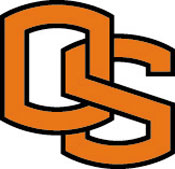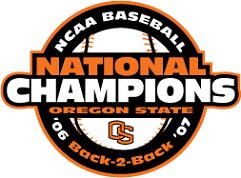
|
BOYS OF SUMMER |

|

|
BOYS OF SUMMER |

|
|
1907 The first intercollegiate athletic event in Oregon State history took place on April 14, 1883, when Oregon Agricultural College faced Monmouth Christian College in a baseball game. Several attempts over the ensuing years to establish baseball as an official sport on the Corvallis campus were defeated by the damp Pacific Northwest weather. Finally, in 1907, varsity baseball was instituted at OAC. The Beavers opened their initial season rather precariously under Coach Joe Fay, losing 4-0 at home to Salem High School, but avenged the loss later, topping the Senators 8-1. OAC finished its first campaign at 5-2. The only opponent on OAC's short schedule that today is part of the Pac-10 Conference was Oregon. The rivals split their home-and-home series, the Ducks winning 9-3 in Eugene and the Beavers prevailing 6-4 in Corvallis. 1952 Oregon State's first trip to the College World Series occurred in 1952. Coached by Ralph Coleman, for whom the OSU baseball field is now named, the Beavers finished regular season play at 10-6 and co-champs with Washington in the Northern Division of the Pacific Coast Conference. By virtue of besting the Huskies during the season series, Oregon State was awarded the post-season berth against the Southern Division champion, Southern California. OSU won the first two games of the three-game set with the Trojans by scores of 12-10 and 5-4 to move on to District competition—another best-of-three series—versus Fresno State. Again the Beavers needed just two games to dispatch their opponent, 2-1 and 8-4, and thus advanced to the College World Series for the first time in school history.
Slugging outfielder Dwayne Helbig (.411 season average) became OSU's first baseball All-American. The 27 total victories recorded in 1952 remained tops until Jack Riley's 1975 Beavers (coincidentally, both the '52 and '75 teams were Northern Division co-champs) posted 28 wins. The Ralph Coleman era produced some other good teams. Especially notable were the 1962 and 1963 squads which won back-to-back PCC Northern Division titles (with identical 11-4 conference records) behind All-American pitching ace Cecil Ira. In 1962, the Beavers lost post-season games to Santa Clara and Fresno State. The next year, Oregons State dropped a three-game set to eventual national champion USC by very similar scores of 5-6, 8-6, and 5-7.
1986 After OSU's initial appearance at the College World Series in 1952, it would not be until the next millennium that Oregon State reached Omaha again. During the interum, it was the 1986 team, coached by Jack Riley, that came closest to qualifying for college baseball's showcase.
The Beavers finished the season at 39-15. The catalyst for the team was pitcher-outfielder-first baseman Dave Brundage. The versatile junior earned All-American (third team) recognition and was drafted by the Philadelphia Phillies. Riley was voted Pac-10 Coach of the Year for the third time in his career. The 1986 squad was the last to earn post-season play of any sort until 2005. Riley retired in 1996 after amassing an overall record of 613-411-5 (.596 winning percentage) during his 21 years at the helm of OSU baseball. His legacy extends beyond the baseball diamond to the administrative battleground. Riley's greatest accomplishment might be that he preserved the sport of baseball at Oregon State. Due to an ailing athletic department budget crippled by issues such as Title IX, refusal by the state legislature to remedy sub-par university funding, and dismal revenue gaps owing to several years of absolutely uncompetitive football teams, the baseball program was axed twice during Riley's tenure. His perseverance rescued the sport which eventually would bring two NCAA championship trophies to Oregon State. Considering the tight fiscal restraints placed on him, it is somewhat remarkable that Riley managed to accomplish as much as he did. His system, known as "Riley's Refinery," developed competitive collegiate baseball players out of unsung prepsters almost exclusively from Oregon high schools. Over the years, Riley-coached teams won nearly 75% of their Pac-10 games.
2005 More than half a century after its first and only trip to the College World Series, Oregon State punched another ticket to Omaha. Picked for sixth in the Pac-10, the Beavers instead finished atop the conference with a record of 19-5, outdistancing second-place Arizona by games. Its 19-5 record reflected the most conference wins since the Northern and Southern Divisions merged in 1999. The 2005 return of OSU to Omaha marks the longest interval between CWS appearances by any school—from 1952 to 2005, a stretch of 53 years.
Unfortunately, Oregon State's second appearance in Omaha mirrored its 1952 performance. OSU was eliminated after dropping two close contests, first to #1-seeded Tulane, 3-1, and then to Baylor 4-3 in 10 innings. The Beavers finished at 46-12 for the season, the most wins in school history to date. The Beavers were led by junior outfielder Jacoby Ellsbury (.415 batting average; 1.000 fielding percentage) who was voted the Pacific-10 Conference Co-Player of the Year. The Boston Red Sox lured Ellsbury away from OSU early by making him their #1 draft pick. Another World Series appearance would come shortly for Ellsbury when the Bosox played the Colorado Rockies in 2007. Ellsbury, along with sophomore pitchers Dallas Buck and Jonah Nickerson, received All-American recognition. Shortstop Darwin Barney was named the conference Freshman of the Year. For the second time, Pat Casey received Pac-10 Coach of the Year honors. 2006 Oregon State's successful defense of its 2005 Pac-10 title set the stage for a season like no other. The 2006 Beavers compiled a 16-7 conference record, finishing two games in front of second-place Arizona State. The NCAA selected Goss Stadium as one of 16 Regional sites. Hawaii, Kansas, and Wright State invaded Corvallis hoping to reach the Super Regional. As it turned out, the Beavers defeated all three teams to advance. OSU remained at home to play its Super Regional competition, Pac-10 enemy Stanford. The Cardinal had upset Texas, the country's #3-seeded team and defending NCAA champion, to advance in hopes of reaching Omaha. OSU had dominated Stanford during conference play, allowing only one run during a three-game sweep in Corvallis. After surviving a 4-3 scare by the Cardinal in the first game of the Super Regional, OSU left no opportunity for upset in the second game, pounding Stanford 15-0. The Beavers were headed back to Omaha! In Oregon State's two previous trips to the College World Series, the Beavers went winless. Consequently, no longer was just a ticket to Omaha satisfactory. OSU's immediate goal, and the hope of its fans, was to finally register a win in Omaha. But based on its first game, against perenniel powerhouse Miami (FL), it looked like it might be another two-and-out for OSU. The Hurricanes had little trouble, winning 11-1.
Although UNC had made several prior trips to the CWS, the Tar Heels had never won a championship, so the Rosenblatt crowd and ESPN viewers were assured of a first-time champion. The Beavers began the title series just as they had begun the tournament, losing the first game thus putting themselves in a must-win situation. OSU dropped the first game 4-3 and trailed early in the second game, 5-0. The celebration buzz was forming in the Carolina crowd when a seven-run, fourth-inning outburst put OSU ahead and completely changed the atmosphere of the series. The Beavers won the game 11-7 and, in the next night's showdown contest, squeaked by 3-2 (aided by four Carolina miscues) to claim only the second NCAA team title in school history. Fans of both teams were shocked—UNC, after winning the first game and building a 5-0 lead in the second, appeared to have the trophy locked up. On the other hand, OSU, entering the CWS without a single victory ever in Omaha, managed to win six games and become the first team north of the Mason-Dixon Line to capture a CWS title in four decades! Oregon State finished at 50-16 overall. Four players, the most ever for the Beavers in one season, were named to various All-America teams—outfielder Cole Gillespie and OSU's tremendous pitching trio of Dallas Buck, Kevin Gunderson, and Jonah Nickerson. All were juniors. Gunderson and Nickerson were selected to play for the USA National Team. Pat Casey was named national Coach of the Year.
2007 Oregon State's quick return to Omaha in 2006 and the NCAA trophy it fetched made that season just about as special as it gets. The 2007 Beavers managed to top it with a season that defies description. After losing seven position players, top two starting pitchers, and star closer, Oregon State's 2007 season was billed as somewhat of a rebuilding job despite coach Pat Casey's remark that he didn't believe in writing off a season and labeling it "rebuilding." The 2007 campaign began remarkably well for the defending NCAA champions. OSU opened at Hawaii-Hilo, where four hurlers combined to no-hit the Vulcans. OSU left the islands with a four-game sweep. The next stop was across the country at Athens, Georgia, to face the UGA Bulldogs. Again, the Beavers invaded hostile territory to sweep their hosts. OSU finished its pre-conference schedule at 23-3 including road wins against Missouri, Arizona State, and Texas A&M. In fact, the Beavers were riding a 12-game win streak heading into conference play. Then some grim reality set in. Oregon State began its Pac-10 schedule at Arizona with a sweep—but this time, the Beavers were the victims. The entire conference schedule was a struggle. OSU, at one early point ranked #2 in the nation, fell on hard times. When the dust all settled, the Beavers were in sixth place with a disappointing record. The team had taken a nosedive since its hot start. Entering the final Pac-10 series against UCLA, the Beavers were just 2-7 against their last three Pac-10 opponents and considered on the bubble for the fast approaching NCAA tournament. It was probably OSU's resolve to win the final league series against UCLA that allowed the Beavers to sneak into the 64-team tourney field. Oregon State was sent to Regional competition in Charlottesville, Virginia. An extra-innings loss to Virginia in the second game left OSU in a dismal spot. But the Beavers rebounded, eliminating Rutgers and putting in motion what has to be one of the most remarkable post-season stretches for any team in NCAA history. OSU then bested the host team twice to advance to the Super Regional. The opponent would be Michigan, which in its Regional play had knocked off Vanderbilt, the top seed in the entire 64-team tournament.
As it would turn out, the toughest challenge for Oregon State in Omaha was its first opponent, Cal State-Fullerton. OSU survived some uncharacteristic ninth-inning jitters to escape with a 3-2 triumph over the Titans. Reversing the pattern of precarious no-margin-for-error scenarios of a year ago, the Beavers swept through the current CWS without a loss, including a spirited victory over Pac-10 rival Arizona State, which held a 3-1 season advantage over OSU. As a matter of fact, Oregon State trailed an opponent only one inning during the entire 45 played in its five games! In a rare development, the Beavers faced their 2006 championship round foe, North Carolina, in a title rematch. This time, OSU dominated the Tar Heels 11-4 and 9-3 to secure successful defense of its national title. Thus, Oregon State joined select company as only the fifth team in history to win back-to-back CWS championships. The five-game sweep of 2007 CWS opponents put Oregon State's overall record in Omaha at 11-6. The Beavers went two-and-out their first two appearances in Omaha, and lost the first game of the 2006 CWS, then 11-1 over their next dozen games at Rosenblatt Stadium. Oregon State finished the season at 49-18. Eight players were drafted off the 2007 squad—shortstop Darwin Barney (Chicago Cubs), catcher Mitch Canham (San Diego Padres), outfielder Chris Hopkins (Kansas City Royals), RHP Eddie Kunz (New York Mets), LHP Anton Maxwell (Texas Rangers), LHP Joe Paterson (San Francisco Giants), RHP Mike Stutes (St. Louis Cardinals), and RHP Dan Turpen (San Francisco Giants). Canham was All-American. Barney was named to the USA National Team. For the second straight year, Pat Casey was national Coach of the Year. |
|
